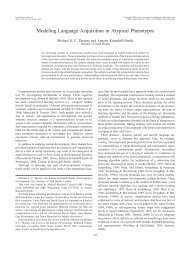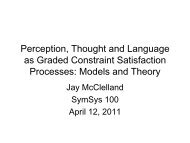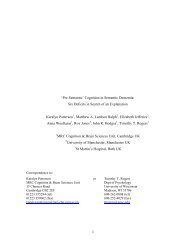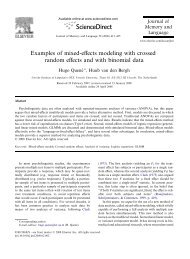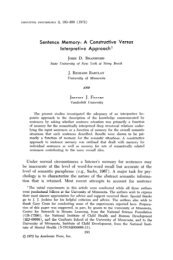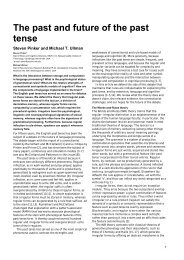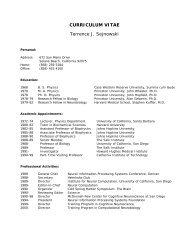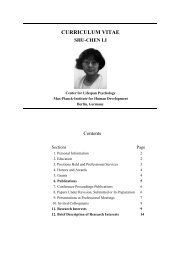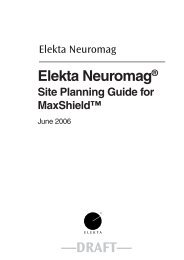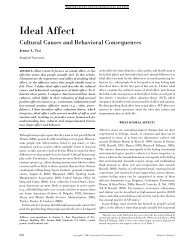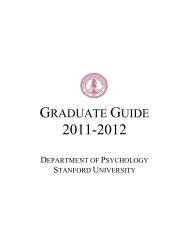A Spiking Neuron Model for Binocular Rivalry - Psychology
A Spiking Neuron Model for Binocular Rivalry - Psychology
A Spiking Neuron Model for Binocular Rivalry - Psychology
Create successful ePaper yourself
Turn your PDF publications into a flip-book with our unique Google optimized e-Paper software.
Journal of Computational Neuroscience 12, 39–53, 2002<br />
c○ 2002 Kluwer Academic Publishers. Manufactured in The Netherlands.<br />
A <strong>Spiking</strong> <strong>Neuron</strong> <strong>Model</strong> <strong>for</strong> <strong>Binocular</strong> <strong>Rivalry</strong><br />
CARLO R. LAING<br />
Department of Mathematics, University of Pittsburgh, Pittsburgh, PA 15260, USA; Department of Physics,<br />
University of Ottawa, 150 Louis Pasteur, Ottawa, Ontario, Canada K1N 6N5<br />
claing@science.uottawa.ca<br />
CARSON C. CHOW<br />
Department of Mathematics, University of Pittsburgh, Pittsburgh, PA 15260, USA<br />
ccc@math.pitt.edu<br />
Received November 27, 2000; Revised October 26, 2001; Accepted November 29, 2001<br />
Action Editor: Kenneth D. Miller<br />
Abstract. We present a biologically plausible model of binocular rivalry consisting of a network of Hodgkin-<br />
Huxley type neurons. Our model accounts <strong>for</strong> the experimentally and psychophysically observed phenomena: (1) it<br />
reproduces the distribution of dominance durations seen in both humans and primates, (2) it exhibits a lack of<br />
correlation between lengths of successive dominance durations, (3) variation of stimulus strength to one eye influences<br />
only the mean dominance duration of the contralateral eye, not the mean dominance duration of the ipsilateral<br />
eye, (4) increasing both stimuli strengths in parallel decreases the mean dominance durations. We have also derived<br />
a reduced population rate model from our spiking model from which explicit expressions <strong>for</strong> the dependence of<br />
the dominance durations on input strengths are analytically calculated. We also use this reduced model to derive an<br />
expression <strong>for</strong> the distribution of dominance durations seen within an individual.<br />
Keywords:<br />
binocular rivalry, multistable perception, visual perception<br />
1. Introduction<br />
<strong>Binocular</strong> rivalry occurs when the two eyes are presented<br />
with drastically different images. Only one of<br />
the images is perceived at a given time, and every<br />
few seconds there is alternation between the perceived<br />
images. The perceived durations of the images are<br />
stochastic and uncorrelated with previous perceived<br />
durations (Fox and Herrmann, 1967; Walker, 1975).<br />
Also, changing the contrast of the images will change<br />
the dominance durations of the perceptions in specific<br />
ways.<br />
It is not yet clear exactly what is rivaling during<br />
binocular rivalry (Lee and Blake, 1999; Logothetis<br />
et al., 1996). It was traditionally thought that the rivalry<br />
was between the two eyes (Blake, 1989; Lehky, 1988).<br />
However, there is more recent evidence that the neurons<br />
at the site(s) of rivalry have access to in<strong>for</strong>mation<br />
from both eyes (Carlson and He, 2000; Kovacs et al.,<br />
1996; Lumer et al., 1998; Ngo et al., 2000), and these<br />
experimental results cannot be explained in terms of<br />
“eye rivalry” (although see Lee and Blake, 1999, <strong>for</strong><br />
an indication of how changing stimulus characteristics<br />
can produce either “eye rivalry” or “stimulus rivalry”).<br />
Recordings in the cortex of monkeys undergoing<br />
binocular rivalry indicate that the neuronal activity<br />
of binocular rather than monocular neurons is<br />
correlated with the perception of one of the presented<br />
images (Leopold and Logothetis, 1996, 1999;<br />
Logothetis, 1998; Logothetis et al., 1996; Logothetis
40 Laing and Chow<br />
and Schall, 1989). The proportion of neurons that are<br />
active only when one of the images is perceived increases<br />
as one moves up the visual pathway (Leopold<br />
and Logothetis, 1999; Logothetis, 1998). It should be<br />
noted that while some neurons are more active when<br />
their preferred image is perceived, others are more active<br />
when their preferred image is suppressed, and yet<br />
others show little selectivity during nonrivalrous stimulation<br />
but become more selective during rivalrous stimulation<br />
(Leopold and Logothetis, 1996; Logothetis,<br />
1998; Logothetis and Schall, 1989).<br />
Several explanations of binocular rivalry have been<br />
proposed (Dayan, 1998; Gomez et al., 1995; Lehky,<br />
1988; Lumer, 1998). One set of theories propose that<br />
the alternation is due to some <strong>for</strong>m of reciprocal inhibition<br />
between the two monocular pathways (Blake,<br />
1989; Lehky, 1988). Many of the existing theories involve<br />
neural network or rate models <strong>for</strong> which making<br />
direct quantitative comparisons with neurophysiological<br />
recordings are not possible.<br />
Our focus is on the specific biophysical mechanisms<br />
responsible <strong>for</strong> binocular rivalry and multistable perception.<br />
We present a network of Hodgkin-Huxley-type<br />
neurons that reproduces the observed psychophysical<br />
and experimental behavior. Our network consists of<br />
both excitatory and inhibitory cells in a biophysically<br />
plausible cortical network. We then present a reduced<br />
population rate model derived from the spiking neuronal<br />
network. We propose that the known observed<br />
phenomena associated with binocular rivalry are direct<br />
consequences of the underlying physiology of coupled<br />
spiking neurons.<br />
We propose that a given percept is represented<br />
as a localized focus of active neurons (Hansel and<br />
Sompolinsky, 1998; Laing and Chow, 2001). In the<br />
simple case of the two presented images being oriented<br />
gratings (Lee and Blake, 1999; Logothetis et al., 1996),<br />
we suggest that a population of neurons is tuned to a<br />
given orientation, and neurons in this population are locally<br />
connected to other neurons with similar preferred<br />
orientations. (We note that our spiking model could<br />
be adapted so that the two foci represent eye images.)<br />
When a grating of a given orientation is presented,<br />
the network receives orientation-specific inputs, and<br />
the local cortical connectivity shapes the activity of the<br />
population to fire maximally at the preferred orientation<br />
with a drop off in activity away from the maximum<br />
in a way that matches the tuning curve of the individual<br />
neurons. One possibility is that this network is situated<br />
at a higher-level visual area, where inputs arrive both<br />
from lower level visual areas and from higher-level<br />
cortical areas.<br />
When two conflicting stimuli are presented, the network<br />
is unable to sustain activity centered around<br />
both inputs simultaneously and thus alternates between<br />
one focus of activity and the other. This switching is<br />
the neurophysiological correlate of binocular rivalry.<br />
The switching is induced by a slow process such as<br />
spike frequency adaptation or synaptic depression. The<br />
dominance duration depends on not only the time scale<br />
of the slow process but also strongly on the input<br />
strength to the network. This allows <strong>for</strong> large variations<br />
in the dominance times even when the time-constant of<br />
the slow process is fixed. Our simulations and analysis<br />
show that the behavior of the network matches the<br />
observed behavior in a number of ways: (1) it reproduces<br />
the distribution of dominance durations seen in<br />
humans and primates, (2) there is a lack of correlation<br />
between lengths of successive dominance durations,<br />
(3) variation of stimulus strength to one eye influences<br />
only the mean dominance duration of the contralateral<br />
eye, not the mean dominance duration of the ipsilateral<br />
eye, (4) increasing both stimuli strengths in<br />
parallel decreases the mean dominance durations, and<br />
(5) rotating the bars so they are no longer orthogonal<br />
increases mean dominance durations. The model’s behavior<br />
when the stimulus strength to one eye is changed<br />
in synchronization with either the suppression or dominance<br />
of the percept presented to that eye also agree<br />
with experimentally observed behavior.<br />
Our model combines local cortical circuits and<br />
higher-level control to explain binocular rivalry. Local<br />
cortical circuits are responsible <strong>for</strong> selecting which<br />
neurons are involved in the particular perception and<br />
inducing the switching between the alternate perceptions.<br />
High-level feedback can play a role in setting<br />
the eventual mean dominance times and can strongly<br />
influence which image is perceived.<br />
2. Hodgkin-Huxley Type <strong>Model</strong><br />
Our model consists of a network of excitatory and<br />
inhibitory Hodgkin-Huxley-type conductance-based<br />
neurons in a biophysical cortical network architecture.<br />
The neurons are orientation selective and receive external<br />
inputs from both eyes and possibly feedback from<br />
higher levels. They have a “preferred orientation” and<br />
fire at a high rate when presented with a grating at<br />
that orientation. To model the experiment in which the
A <strong>Spiking</strong> <strong>Neuron</strong> <strong>Model</strong> <strong>for</strong> <strong>Binocular</strong> <strong>Rivalry</strong> 41<br />
two eyes are presented with orthogonal gratings, we<br />
inject currents at two locations in the network centered<br />
around neurons whose preferred orientations differ by<br />
90 degrees. The spatial structure of the current input is<br />
Gaussian (see Fig. 1 and Eq. (20)). Note that since<br />
there is no eye-specific in<strong>for</strong>mation in the network,<br />
this model is also appropriate <strong>for</strong> the study of monocular<br />
viewing of orthogonal sinusoidal gratings (Andrews<br />
and Purves, 1997; Walker, 1976). In these experiments,<br />
periods of mixed perception are intermingled with periods<br />
of exclusive visibility of one or the other pattern.<br />
We assume that excitatory cells are synaptically coupled<br />
to other excitatory cells with a strength that decays<br />
as a Gaussian function of the difference between<br />
their preferred orientations. There is also coupling with<br />
a Gaussian footprint from excitatory neurons to inhibitory<br />
neurons, between inhibitory neurons, and from<br />
inhibitory neurons to excitatory neurons, with the variable<br />
always being the difference in preferred orientations.<br />
The equations and parameter values are given in<br />
the Methods section.<br />
We include two slow processes. The first is spike<br />
frequency adaptation due to a calcium-dependent<br />
potassium current (Huguenard and McCormick, 1992;<br />
McCormick and Huguenard, 1992). This is sufficient<br />
to cause oscillations in the network’s activity, although<br />
they occur on a similar time-scale to the time constant<br />
of the decay of this current, ∼80 ms. We also include<br />
synaptic depression in the excitatory to excitatory connections<br />
that has a larger time-constant (Abbott et al.,<br />
1997). We find that synaptic depression alone is not<br />
sufficient to cause switching: we need a slow hyperpolarizing<br />
current as well. The switching phenomenon<br />
is quite robust with respect to the exact strengths and<br />
time-scales of these slow variables.<br />
For simplicity, we explicitly model only those<br />
neurons whose activity increases when their preferred<br />
stimuli are perceived. Those neurons that respond<br />
preferentially when their preferred stimuli are suppressed<br />
may be part of a different circuit that is involved<br />
in suppression of a particular image or eye,<br />
and those whose selectivity changes when the stimulus<br />
is changed from rivalrous to nonrivalrous may<br />
be manifesting the effects of attention on perception<br />
(Leopold and Logothetis, 1996; Logothetis, 1998;<br />
Logothetis and Schall, 1989). <strong>Neuron</strong>s in these last two<br />
classes are not explicitly modeled. Those neurons possibly<br />
involved in suppressing an image are similar to<br />
those that fire when their preferred stimulus is dominant<br />
(both groups fire when one image is suppressed) and<br />
our model could be augmented to include such neurons.<br />
2.1. Simulation Results<br />
Figure 2 shows a rastergram of the firing events of the<br />
excitatory neurons in the network given two current<br />
Figure 1. Two coupled networks of binocular, orientation-selective<br />
neurons. The neurons are labeled with their preferred orientation in<br />
degrees. Current is injected to two groups of neurons whose preferred<br />
orientations differ by 90 degrees.<br />
Figure 2. Activity in the excitatory population as a function of time.<br />
The current stimuli are centered at neurons 15 and 45. The right plot<br />
shows detail of the left plot.
42 Laing and Chow<br />
stimuli centered at neurons whose preferred orientations<br />
differ by 90 degrees. At every moment in time,<br />
the activity is localized into a bump that is centered at<br />
either of the two locations of maximum external current<br />
input. A bump in one of these locations is thought<br />
to represent a perception of bars of the corresponding<br />
orientation. The inhibitory neuron activity is very similar<br />
although it has a greater angular spread. Note the<br />
wide spread of activity, lasting less than 100 ms, when<br />
the activity initially moves to another location. The decrease<br />
in width after this period is probably due to the<br />
adaptation current saturating. This type of high activity<br />
at the onset of a percept is seen in some neurons<br />
in superior temporal sulcus and inferior temporal cortex<br />
during binocular rivalry (Leopold and Logothetis,<br />
1999; Sheinberg and Logothetis, 1997). Experimentally,<br />
bursting behavior is also seen in some of these<br />
neurons. Replacing some of the fast excitatory synapses<br />
in our model with slower NMDA-type synapses (as<br />
in Wang, 1999) causes neurons in a bump to burst in<br />
an approximately synchronous fashion while active,<br />
rather than fire approximately periodically and asynchronously<br />
(results not shown). The network is capable<br />
of sustaining only one bump at any given time, and<br />
since the neurons are coupled synaptically, the subthreshold<br />
inputs to the currently suppressed bump do<br />
not affect the currently active bump.<br />
Figure 3 shows the voltage trace from a typical neuron<br />
in a bump. Note the slower firing rate at the end of<br />
a firing episode relative to that at the start. This simulation<br />
used a total of 60 excitatory and 60 inhibitory<br />
neurons and had no external noise. Similar switching<br />
behavior is seen when larger numbers of neurons<br />
are used, but we do not show results <strong>for</strong> these larger<br />
networks because of the prohibitively large amounts of<br />
computer time required <strong>for</strong> such simulations.<br />
A histogram of dominance durations is shown in<br />
Fig. 4. It is unimodal and skewed, with a long tail<br />
at long durations. Included are fits to the data of a<br />
Gamma function that is commonly (Kovacs et al., 1996;<br />
Logothetis et al., 1996), although not always (Gomez<br />
et al., 1995; Lehky, 1995), fitted to such data, along with<br />
another function Eq. (12) that is derived in Section 3.1.<br />
Figure 5 shows the autocorrelation coefficients <strong>for</strong> the<br />
data in Fig. 4. The lack of any strong correlation beyond<br />
zero lag is clearly seen, in agreement with observations<br />
(Lehky, 1988, 1995; Logothetis et al., 1996).<br />
The Lathrop statistic (Logothetis et al., 1996), which<br />
measures the correlation between successive values in<br />
a time series, was calculated ( ¯L = 0.977, σ = 0.073,<br />
Figure 3. Voltage of the 38th neuron in Fig. 2. Note the different<br />
horizontal scales in the lower two plots. The apparent difference in<br />
spike heights is a result of plotting voltage at discrete values of time.<br />
Figure 4. The distribution of dominance durations <strong>for</strong> the Hodgkin-<br />
Huxley model. The solid line is Eq. (12) with parameters γ = 0.0174,<br />
η =−0.0005, κ = 0.0782, τ = 1.1389, and the dashed is a Gamma<br />
distribution with λ = 2.3593 and r = 6.7381, where the Gamma distribution<br />
is f (t) = λ r /Ɣ(r)t r−1 exp(−λt).
A <strong>Spiking</strong> <strong>Neuron</strong> <strong>Model</strong> <strong>for</strong> <strong>Binocular</strong> <strong>Rivalry</strong> 43<br />
Figure 5. Autocorrelation coefficients <strong>for</strong> the data in Fig. 4.<br />
giving a z value of 0.31), and this confirms the lack of<br />
a significant correlation. A simple explanation <strong>for</strong> this<br />
lack of correlation in a completely deterministic system<br />
is that the system is chaotic: the maximum Lyapunov<br />
exponent is approximately 40 s −1 . Since typical dominance<br />
durations are much longer than the reciprocal<br />
of this quantity, switching times can be thought of as<br />
resulting from an extreme “undersampling” of the underlying<br />
dynamical system, and successive dominance<br />
durations will not be correlated (Racicot and Longtin,<br />
1997). This interpretation as undersampling also provides<br />
an explanation of the results of Lehky (1995)<br />
who, by analyzing a time series of dominance durations,<br />
concluded that the underlying dynamical system<br />
was not a low-dimensional chaotic attractor. Both<br />
Kalarickal and Marshall (2000) and Lehky (1988) studied<br />
simple models of binocular rivalry that showed<br />
this lack of serial correlation, but both models had<br />
stochastic inputs.<br />
As a result of the spatial structure of both the external<br />
current inputs and the coupling, neurons in the<br />
network have a range of different input currents and<br />
hence fire at different average frequencies (Hansel and<br />
Sompolinsky, 1998; Laing and Chow, 2001). Thus, the<br />
neurons cannot synchronize, and there should not be<br />
any strong correlations between firing times of different<br />
neurons although weak correlations are possible<br />
(Gutkin et al., 2001). As the number of neurons in<br />
the network increases, fluctuations in the synaptic input<br />
to a given neuron should decrease. The observed<br />
nonzero variance of experimentally obtained distributions<br />
is thought to be due to both fluctuations from the<br />
finite number of neurons in the network and synaptic,<br />
channel or external noise.<br />
The switching can be understood heuristically. In<br />
Section 3 we give a more quantitative explanation. Consider<br />
two input stimuli 1 and 2. Connections between<br />
excitatory neurons promote activity centered at<br />
stimulus 1 or 2, while inputs from the inhibitory population<br />
prevent this activity from spreading over the<br />
whole network. This inhibitory activity is also strong<br />
enough to suppress activity at the site corresponding<br />
to the stimulus that is not perceived. (For sufficiently<br />
strong inputs, two bumps may coexist). Suppose that<br />
population 1 is active and 2 is suppressed, and consider<br />
the effects of the slow current responsible <strong>for</strong><br />
spike frequency adaptation. This current increases at<br />
site 1 and decreases at site 2 until eventually the adaptation<br />
remaining from activity at site 2 has decreased<br />
sufficiently that the neurons at site 2 are able to fire<br />
again, immediately suppressing the neurons at site 1.<br />
The adaptation current at site 2 then builds up, the adaptation<br />
current at site 1 wears off sufficiently, and the cycle<br />
repeats. A similar argument can be made if synaptic<br />
depression is the cause of the switching: both the recurrent<br />
excitation at site 1 and the inhibition of the neurons<br />
at site 2 weaken, allowing neurons at site 2 to fire and<br />
suppress neurons at site 1.<br />
One well-known aspect of binocular rivalry is that if<br />
the strength of the stimulus to one eye is changed, it is<br />
largely the mean dominance duration of the other eye<br />
that is affected, not the mean dominance duration of<br />
the eye whose stimulus strength is being changed. This<br />
effect is sometimes known as Levelt’s second proposition<br />
(Bossink et al., 1993; Levelt, 1968) and has been<br />
observed many times (Leopold and Logothetis, 1996;<br />
Logothetis et al., 1996; Mueller and Blake, 1989). More<br />
specifically, if the strength of the stimulus to eye 1 is<br />
decreased, the mean dominance duration of eye 2 typically<br />
increases markedly in a nonlinear fashion, while<br />
the mean dominance duration of eye 1 decreases by a<br />
small amount. We per<strong>for</strong>med this experiment with our<br />
model, and the results are shown in Fig. 6 (together<br />
with data from the reduced model that is presented in<br />
Section 3). They agree well with observations, and an<br />
explanation <strong>for</strong> this behavior is given in Section 3.<br />
Another experiment that has been per<strong>for</strong>med involves<br />
changing the angle between the two sets of bars<br />
presented to the two eyes. It has been observed that<br />
decreasing the angle from 90 degrees causes the mean<br />
dominance durations to increase (Andrews and Purves,<br />
1997). We per<strong>for</strong>med this experiment on our model,<br />
and the results are shown in Fig. 7. The variation is<br />
small (as it is in experiments) (Andrews and Purves,
44 Laing and Chow<br />
Figure 6. A demonstration of Levelt’s second proposition in a spiking<br />
neuron model. The strength of one input was fixedat0.4 and the<br />
other was reduced. × is mean dominance duration <strong>for</strong> the stimulus<br />
whose strength was decreased, ◦ is mean dominance duration <strong>for</strong><br />
the stimulus whose strength was unchanged. Compare with Leopold<br />
and Logothetis (1996, Fig. 1), Logothetis et al. (1996, Fig. 4), or<br />
Mueller and Blake (1989, Fig. 2). Also shown are rescaled dominance<br />
durations from the reduced model (1) through (6) (dashed and<br />
dash-dotted). See text <strong>for</strong> details.<br />
If these widths were reduced, smaller angular differences<br />
could have been tested, but the total number of<br />
neurons in the network would have then had to be<br />
correspondingly increased, resulting in prohibitively<br />
long simulation times. An explanation <strong>for</strong> the dependence<br />
of dominance duration on angle between bars is<br />
given in Section 3.<br />
A further experiment of interest is that of Mueller and<br />
Blake (1989). They changed the strength (contrast) of<br />
the stimulus presented to one eye, but the change was<br />
only made during either dominance or suppression of<br />
that image. For example, if the manipulation is synchronized<br />
with dominance of an eye, the contrast of<br />
the image presented to that eye is changed when that<br />
image is reported as being dominant and is returned to<br />
the baseline level when the image is no longer reported<br />
as being dominant. We per<strong>for</strong>med this experiment with<br />
our model, and the results are shown in Fig. 8. The<br />
Figure 7. Variation of mean dominance duration as a function of<br />
the angle between two sets of gratings presented to the two eyes.<br />
Smaller angular differences could not be tested, since <strong>for</strong> these values<br />
the two bumps “merged.” The bars indicate the standard deviation of<br />
the dominance durations. Compare with Andrews and Purves (1997,<br />
Fig. 4B(i)).<br />
1997) but significant. Smaller angular differences could<br />
not be tested, as this caused the two bumps to “merge”<br />
into one that spanned both input positions. This is due to<br />
the widths of the Gaussians used in coupling neurons.<br />
Figure 8. The effects of changing the strength of one input in the<br />
spiking neuron model, synchronized to either the suppression of that<br />
image (top) or the dominance of that image (bottom), as described<br />
by Mueller and Blake (1989). The strength of one input was fixed at<br />
0.4, and the other was reduced. × is mean dominance duration <strong>for</strong><br />
the stimulus whose strength was decreased, ◦ is mean dominance<br />
duration <strong>for</strong> the stimulus whose strength was unchanged. Compare<br />
with Mueller and Blake (1989, Fig. 4).
A <strong>Spiking</strong> <strong>Neuron</strong> <strong>Model</strong> <strong>for</strong> <strong>Binocular</strong> <strong>Rivalry</strong> 45<br />
results <strong>for</strong> the case where the stimulus strength is synchronized<br />
with suppression of that image (Fig. 8, top)<br />
are very similar to the situation described above as<br />
Levelt’s second proposition—i.e., if the stimulus<br />
strength is decreased, the dominance duration of the<br />
ipsilateral eye is largely unaffected, but the dominance<br />
duration of the contralateral eye increases markedly<br />
(compare Fig. 8, top, with Fig. 6). The results shown<br />
in this figure agree well with experimental results<br />
(Mueller and Blake, 1989, Fig. 4). The case when the<br />
stimulus strength is synchronized with dominance of<br />
the image is shown in Fig. 8, bottom. It is seen that<br />
decreasing the stimulus strength slightly decreases the<br />
dominance duration of the ipsilateral eye but leaves<br />
the dominance duration of the contralateral eye essentially<br />
unchanged. This is also in good agreement with<br />
experimental results (Mueller and Blake, 1989). An explanation<br />
<strong>for</strong> this behavior is given in Section 3.<br />
3. Reduced Description<br />
We make our heuristic arguments more precise with a<br />
reduced spatially averaged model. The resulting equations<br />
are similar to the proposed models of Kalarickal<br />
and Marshall (2000), Lehky (1988), Mueller (1990),<br />
and Wilson et al. (2000). In Appendix B we describe<br />
how the following equations can be derived from our<br />
spiking neuronal network. They represent the spatially<br />
averaged dynamics of two populations of Hodgkin-<br />
Huxley-type neurons with recurrent excitation, crossinhibition,<br />
adaptation, and synaptic depression:<br />
du 1<br />
=−u 1 + f (αu 1 g 1 − βu 2 g 2 − a 1 + I 1 )<br />
dt<br />
(1)<br />
du 2<br />
=−u 2 + f (αu 2 g 2 − βu 1 g 1 − a 2 + I 2 )<br />
dt<br />
(2)<br />
da 1<br />
τ a =−a 1 + φ a f (αu 1 g 1 − βu 2 g 2 − a 1 + I 1 )<br />
dt<br />
(3)<br />
da 2<br />
τ a =−a 2 + φ a f (αu 2 g 2 − βu 1 g 1 − a 2 + I 2 )<br />
dt<br />
(4)<br />
dg 1<br />
τ d = 1 − g 1 − g 1 φ d f (αu 1 g 1 − βu 2 g 2 − a 1 + I 1 )<br />
dt<br />
(5)<br />
τ d<br />
dg 2<br />
dt<br />
= 1 − g 2 − g 2 φ d f (αu 2 g 2 − βu 1 g 1 − a 2 + I 2 ),<br />
(6)<br />
where all constants are positive. Here u i represents the<br />
spatially averaged net excitatory activity of each localized<br />
population seen in the simulations of the spiking<br />
neurons (i = 1, 2 labels the percept or “bump”), a i and<br />
g i are the population adaptation and synaptic depression<br />
variables, respectively. We have included synaptic<br />
depression in both the excitatory and inhibitory connections.<br />
While depression is thought to occur in only<br />
excitatory synapses, the inhibitory neurons in the full<br />
spiking model are largely driven by the excitatory population,<br />
and it is the depression in the excitatory to excitatory<br />
connections that leads to this decrease in inhibitory<br />
activity on the time-scale of the depression, so this is<br />
not an unreasonable choice. For simplicity we take the<br />
gain function f to be the Heaviside step function—<br />
i.e., f (x) = 1 <strong>for</strong> x ≥ 0 and f (x) = 0 <strong>for</strong> x < 0. The<br />
constants τ a and τ d are the time constants of the adaptation<br />
and synaptic depression, respectively, and are<br />
both assumed to be much larger than 1. A high level of<br />
u i is assumed to be directly correlated with the perception<br />
of image i. The chaotic dynamics of the spiking<br />
network are not represented in these reduced equations.<br />
They could be mimicked by including stochastic <strong>for</strong>cing<br />
terms.<br />
The dynamics of (1) through (6) are fairly simple<br />
because of the separation of time-scales between the<br />
activities and the slow variables. Depending on the parameters,<br />
the system either oscillates or goes to a steady<br />
state. The only possible steady states are both activities<br />
at zero (both off), both activities at 1 (both on), or one<br />
at 1 and the other at zero (one on) and its mirror image.<br />
For clarity, first consider the case where only adaptation<br />
is active (i.e., g 1 = g 2 = 1 and we ignore Eqs. (5)<br />
and (6)). For the both-off steady state, the variables<br />
satisfy (u 1 , u 2 , a 1 , a 2 ) = (0, 0, 0, 0). For this state to<br />
exist, the total inputs of the gain functions must be<br />
below threshold—i.e., I 1 < 0 and I 2 < 0. For the bothon<br />
fixed state, (u 1 , u 2 , a 1 , a 2 ) = (1, 1,φ a ,φ a ). In this<br />
case, the inputs must be greater than threshold—i.e.,<br />
α − β − φ a + I 1 > 0 and α − β − φ a + I 2 > 0. Thus,<br />
strong inputs or strong excitation is required <strong>for</strong> the<br />
both-on state. The one-on case has (u 1 , u 2 , a 1 , a 2 ) =<br />
(1, 0,φ a , 0) or its mirror image. This requires α − φ a +<br />
I 1 > 0 and I 2 − β
46 Laing and Chow<br />
Repeating <strong>for</strong> a 1 we get the same equation but with the<br />
indices reversed. This then allows us to solve <strong>for</strong> T 1<br />
and T 2 to obtain<br />
( )<br />
I2 − β<br />
T 1 =−τ a log<br />
,<br />
β + φ a − I 1<br />
(<br />
I1 − β<br />
T 2 =−τ a log<br />
β + φ a − I 2<br />
)<br />
.<br />
(9)<br />
Figure 9. Solution of the reduced model (1) through (4). Parameter<br />
values are α = 0.2, β = 0.4, φ a = 0.4, τ a = 20, I 1 = 0.43, I 2 = 0.5,<br />
g 1 = g 2 = 1. The top plot is u 1 and a 1 , the bottom is u 2 and a 2 .<br />
increasing inhibition to u 1 , causing it to decrease. The<br />
process then repeats and oscillations ensue. We equate<br />
the duration that each population is turned on with the<br />
dominance time of the corresponding percept.<br />
An example is shown in Fig. 9. Parameter values are<br />
α = 0.2, β = 0.4, φ a = 0.4, τ a = 20, I 1 = 0.43, I 2 = 0.5.<br />
One population becomes active only when its adaptation<br />
has worn off by a sufficient amount. For the<br />
parameters shown, population 1 switches on when<br />
a 1 = I 1 − β = 0.03 and population 2 switches on when<br />
a 2 = I 2 − β = 0.1.<br />
We can calculate the dominance period by following<br />
the dynamics of the adaptation variable. It has a<br />
growing phase (a i (t) ≡ a g i<br />
(t)) and a decaying phase<br />
(a i (t) ≡ ai d(t)). Let T 1 be the dominance period of<br />
percept 1 (decay phase of a 2 ) and T 2 be that of percept<br />
2 (decay phase of a 1 ). T 1 is obtained from the condition<br />
These are shown in Fig. 10, top. It is clear that T 1 is<br />
largely independent of I 1 , while T 2 has a strong dependence<br />
on I 1 . This is an explanation <strong>for</strong> Levelt’s second<br />
proposition.<br />
One notable difference between the curves in Fig. 10,<br />
top, and the data in Fig. 6 <strong>for</strong> the spiking neuron model<br />
(and also those reported in Leopold and Logothetis,<br />
1996; Logothetis et al., 1996; and Mueller and Blake,<br />
1989) is that T 1 increases as I 1 is decreased in (9), in<br />
contrast with the other results above. (The qualitative<br />
I 2 − β − a d 2 (T 1) = 0, (7)<br />
where time is measured from the onset of percept 1.<br />
Solving (4) in the decaying phase gives a2 d(t) = ad 2 (0)<br />
exp(−t/τ a ). We need to compute a2 d (0). We first<br />
note that a g 2 (t) = φ a + (I 2 − β − φ a ) exp(−t/τ a ) in the<br />
growing phase, where time is now measured from the<br />
onset of percept 2, and that a2 d(0) = ag 2 (T 2). This<br />
yields<br />
I 2 − β − [φ a + (I 2 − β − φ a ) exp(−T 2 /τ a )]<br />
× exp(−T 1 /τ a ) = 0. (8)<br />
Figure 10. Dominance durations with only adaptation considered.<br />
Top: Eqs. (1) through (4) with g 1 = g 2 = 1, as given by (9). T 1 is<br />
dashed and T 2 is solid. Note the slight increase in T 1 as I 1 is decreased,<br />
in contrast with Fig. 6. Parameter values are α = 0.2,β = 0.4,φ a =<br />
0.4,τ a = 20, I 2 = 0.5. Bottom: Dominance duration as a function<br />
of input (I ), when the inputs to (1) through (4) are equal (i.e., I 1 =<br />
I 2 = I ). Other parameters are as above.
A <strong>Spiking</strong> <strong>Neuron</strong> <strong>Model</strong> <strong>for</strong> <strong>Binocular</strong> <strong>Rivalry</strong> 47<br />
nature of the behavior predicted by (9) was also seen in<br />
the spiking neuron model when no synaptic depression<br />
was included; results not shown.) However, adding the<br />
effects of depression to those of adaptation in the model<br />
(1) through (6) can produce qualitative agreement between<br />
the behavior of T 1 as a function of I 1 <strong>for</strong> the<br />
reduced model, and the spiking model and experimental<br />
results mentioned above (see below).<br />
From expressions (9) we can determine the dependence<br />
of dominance duration on input when the inputs<br />
have equal strength—i.e., I 1 = I 2 = I :<br />
( ) I − β<br />
T =−τ a log<br />
. (10)<br />
β + φ a − I<br />
This is shown in Fig. 10, bottom. We see that as I is<br />
decreased, the dominance durations increase, as observed<br />
experimentally. Also, there is a critical value of<br />
I (I = β) such that <strong>for</strong> I
48 Laing and Chow<br />
functions of I 1 when I 2 was held constant. (Note that T 1<br />
decreases as I 1 is decreased.) The parameter values are<br />
α = 0.35, β = 0.2, φ a = φ d = 0.6, τ a = 20, τ d = 40,<br />
and the rescalings are x = (0.11I 1 + 0.064)/0.27 and<br />
t = T 1,2 /20 + 2.1, where x is the strength of the current<br />
input <strong>for</strong> the spiking neuron model (Eq. (20)), and<br />
t is the dominance duration in seconds. Note that these<br />
rescalings can be absorbed into the parameters of the<br />
model (1) through (6), and do not represent any physical<br />
changes. The curves in Fig. 6 are not meant to be a fit<br />
to the data from the spiking model but to indicate that<br />
an appropriate mixture of adaptation and depression<br />
in the simple model (1) through (6) can qualitatively<br />
reproduce observed behavior.<br />
This analysis shows that the dominance durations<br />
can vary over a wide range depending on the strength<br />
of the inputs. Thus even though the mechanism <strong>for</strong><br />
switching may be adaptation, synaptic depression or<br />
a combination of these two, and these processes are<br />
likely to have relatively uni<strong>for</strong>m time constants between<br />
subjects, there could still be wide variations in<br />
the dominance durations between subjects due to differences<br />
in actual input strengths. The sources of the<br />
binocular inputs in our model are not specified, and we<br />
envision them as being due to combined inputs from<br />
lower visual regions and higher cortical regions. We<br />
postulate that variations in these inputs could be the<br />
reason <strong>for</strong> the wide variation in dominance times seen<br />
in psychophysical experiments (Pettigrew and Miller,<br />
1998).<br />
3.1. Distribution of Dominance Durations<br />
We can also use this reduced model to explain the distribution<br />
of dominance durations observed in the simulations<br />
of our spiking neuronal network. As noted in<br />
the above analysis, the switching of one percept to the<br />
other is controlled by the release from inhibition due to<br />
the decay back to the resting value of the adaptation or<br />
synaptic depression variable. If we include the effects<br />
of the fluctuations due to the chaotic dynamics (or noise<br />
effects), then this decay will be a stochastic process.<br />
Consider the example of adaptation only. During decay<br />
the adaptation current obeys a d (t) = a 0 exp(−t/τ).<br />
When a d decays below a threshold level, the inhibited<br />
neurons will fire. However, with fluctuations the threshold<br />
value will be a stochastic variable, and a 0 will not<br />
be the same <strong>for</strong> each dominance period. Consider the<br />
simplified case where the threshold is reset to a random<br />
variable chosen from a Gaussian distribution, and a 0 is<br />
randomly chosen from another Gaussian distribution,<br />
each time a d is reset. The distribution of dominance<br />
durations is then<br />
( e −T/τ [γ + ηκe −T/τ )<br />
]<br />
p(T ) = <br />
[γ + κe −2T/τ ] 3/2<br />
( −[e −T/τ − η] 2 )<br />
× exp<br />
, (12)<br />
2(γ + κe −2T/τ )<br />
where ,γ,κ and η are related to the parameters of<br />
the two Gaussian distributions. See Appendix C <strong>for</strong> the<br />
derivation. This function is plotted in Fig. 4 together<br />
with data from the simulation of the full Hodgkin-<br />
Huxley network. It fits the data well and has the typical<br />
skewed shape seen in experimental data (Kovacs et al.,<br />
1996; Logothetis et al., 1996).<br />
4. Discussion<br />
Our cortical circuit of excitatory and inhibitory neurons<br />
is able to reproduce many of the observed dynamical<br />
characteristics of binocular rivalry. We are also able<br />
to compute analytically the dependence of the dominance<br />
period on the input strengths, and this shows<br />
how Levelt’s second proposition can arise naturally in<br />
a network with mutual inhibition.<br />
We find that the input strength to the network<br />
strongly influences the dominance duration. This allows<br />
large variations in the dominance durations even<br />
with fixed adaptation and synaptic depression timescales.<br />
The large distribution in mean times between<br />
subjects could be due to the differential input to the<br />
local circuit—this may be especially true of feedback<br />
from higher-level cortical areas—and the strength of<br />
this contribution could vary widely between subjects<br />
and even change within a subject. The neuromodulators<br />
acetylcholine, histamine, norepinepherin, and<br />
serotonin are all known to decrease the effects of spike<br />
frequency adaptation in human cortex (McCormick and<br />
Williamson, 1989), and if adaptation is the main mechanism<br />
<strong>for</strong> switching, changes in their concentration<br />
would significantly affect mean dominance durations.<br />
It is known that there is some training effect in binocular<br />
rivalry and multistable perception (Leopold and<br />
Logothetis, 1999), and systematic changes in switching<br />
frequency on the time-scale of several minutes<br />
have been observed (Borsellino et al., 1972; Lehky,<br />
1995). Also, knowledge that a stimulus is ambiguous<br />
and has more than one possible perception plays a role<br />
in switching (Rock et al., 1994).
A <strong>Spiking</strong> <strong>Neuron</strong> <strong>Model</strong> <strong>for</strong> <strong>Binocular</strong> <strong>Rivalry</strong> 49<br />
There are instances when rivalry does not take place.<br />
It is known that if the stimulus contrast is reduced, the<br />
images from the two eyes can fuse into a single merged<br />
percept (Leopold and Logothetis, 1999). Presumably,<br />
this fixed percept corresponds to a “fixed” pattern of<br />
activation. In our model, reducing the input stimulus<br />
causes the duration periods to increase until rivalrous<br />
oscillations cease. The ensuing fixed state depends on<br />
the type of slow process in the system. If only adaptation<br />
is included, then the network goes to the both-off<br />
state. If only depression is included, then the network<br />
can go into either the both-on state or the one-on state.<br />
With a combination of adaptation and depression either<br />
of the fixed states are possible. However, since<br />
our network is assumed to represent binocular in<strong>for</strong>mation<br />
about orientation of gratings, it is unclear how<br />
fusion would be represented: it may not simply be a<br />
state where the network is in the “both-on” state. The<br />
local network we model may only represent the orientation<br />
of images, and the perception of grid images<br />
may be represented by a different set of neurons. One<br />
possible scenario is that the orientation network, when<br />
active, inhibits the network of grid neurons. Fusion<br />
then arises when the orientation network is inactive,<br />
thereby releasing the inhibition on the grid network. In<br />
this scenario, the both-off state in our network would<br />
correspond to fusion.<br />
A lack of rivalry also occurs if the angular sizes of<br />
the images are increased beyond a given level. What<br />
is perceived instead is a constantly changing spatial<br />
patchwork of both images (Blake, 1989) or a traveling<br />
wave if the image is restricted to an essentially onedimensional<br />
annulus (Wilson et al., 2001). Our cortical<br />
network may represent orientation <strong>for</strong> only a single<br />
spatial location, and the spatial patchwork may arise<br />
if there are many networks of the type we have studied,<br />
each corresponding to a different spatial location,<br />
and there is some <strong>for</strong>m of local coupling between such<br />
networks. For strong input strength, either both-on or<br />
one-on states are possible in our model.<br />
Our simulations show that switching caused by depression<br />
is much less robust to noise than switching<br />
caused by adaptation. The reason <strong>for</strong> this is probably<br />
that if depression is used, the switching occurs because<br />
the balance between excitation and inhibition gradually<br />
changes during a dominance period, finally reaching<br />
a critical value. This balance is quite fragile, and<br />
external noise will upset it, causing switching. However,<br />
switching caused by the wearing off of adaptation<br />
in the <strong>for</strong>m of a slow hyperpolarizing current<br />
seems more robust since the network will not switch<br />
until the current is close to threshold. Small to moderate<br />
amounts of noise will not change the magnitude of<br />
the current that is wearing off, acting instead to make<br />
the threshold a stochastic function of time rather than<br />
a constant. One modification of the depression mechanism<br />
that could make it more robust is the inclusion<br />
of not only depression between excitatory neurons, but<br />
facilitation in the connections from excitatory to inhibitory<br />
neurons (Markram et al., 1998), on an appropriate<br />
time-scale. We have seen that both adaptation and<br />
depression have advantages and disadvantages with regards<br />
to modeling binocular rivalry, and in practice it is<br />
likely that they both contribute. It is worth noting that<br />
in both the spiking neuron and reduced models, the<br />
only way to obtain the correct dependence of the mean<br />
dominance duration of the ipsilateral eye on stimulus<br />
strength when testing Levelt’s second proposition was<br />
to include both spike frequency adaptation and synaptic<br />
depression. This suggests that both are present in<br />
the relevant circuits of the cortex.<br />
Our reduced model was anticipated by Lehky (1988),<br />
who proposed a neural network model of binocular rivalry<br />
that involved reciprocal inhibitory feedback between<br />
signals from the two eyes, prior to binocular<br />
convergence. He created an electronic circuit to represent<br />
the network, and <strong>for</strong> strong enough reciprocal<br />
inhibition the circuit oscillated. The oscillations<br />
stopped <strong>for</strong> weak inhibition, which Lehky attributed<br />
to fusion. He could reproduce Levelt’s second proposition<br />
by changing the adaptation rates on either neuron<br />
and postulated that changing stimulus strength changes<br />
adaptation rates.<br />
Recently, Kalarickal and Marshall (2000) numerically<br />
studied a model similar to (1) through (6), with<br />
noise but not including adaptation. Their model reproduced<br />
Levelt’s second proposition, the lack of correlation<br />
between successive dominance durations, and the<br />
results of Mueller and Blake (1989) relating to synchronized<br />
changes in input strengths. They also realized that<br />
it is the total input to the inactive population that determines<br />
the time <strong>for</strong> which the active population remains<br />
active (thus explaining Levelt’s second proposition and<br />
the results of Mueller and Blake, 1989), but the advantage<br />
of our reduced model (1) through (6) over their<br />
model is that the dependence of dominance duration<br />
on input can be explicitly derived.<br />
Mueller (1990) presented a reduced model similar<br />
to (1) through (6) but without noise and by trial and<br />
error chose parameters so that his model reproduced the
50 Laing and Chow<br />
results of Mueller and Blake (1989). However, due to<br />
the complexity of his model, little analytical insight can<br />
be gained regarding the mechanisms or the underlying<br />
physiology.<br />
Wilson et al. (2000) studied the oscillations in the<br />
perception of circles in static periodic dot patterns<br />
(Marroquin patterns) using a planar network of 64 by<br />
64 coupled “spike-rate” units, each of which is analogous<br />
to our rate model (1) through (6), although<br />
these authors did not include synaptic depression.<br />
Their adaptation variable’s time-constant determines<br />
the slow (on the order of a few seconds) perceived<br />
switching between circles. They also fit a Gamma function<br />
to their distribution of dominance periods. They<br />
did not include noise in the simulations, so the width<br />
of the histogram of observed dominance periods is due<br />
to the complex, possibly chaotic, behavior of a highdimensional<br />
dynamical system.<br />
A third alternative model that we could have studied<br />
is a spatially extended rate model, similar to that of<br />
Wilson et al. (2000). Using Gaussian connectivity similar<br />
to that used in the Hodgkin-Huxley-type model (see<br />
Appendix A), but using rate units with dynamics similar<br />
to (1) through (6), we obtain bumps similar to those<br />
seen in other rate models (Hansel and Sompolinsky,<br />
1998; Laing and Chow, 2001). By adding spatially inhomogeneous<br />
currents and enough adaptation and/or<br />
depression, we obtain bumps that alternate in a way<br />
similar to those shown in Fig. 2 (results not shown).<br />
The main difference between a spatially extended rate<br />
model and a spatially extended spiking neuron model<br />
is that alternation of bumps in the <strong>for</strong>mer is strictly periodic<br />
(as it is in, e.g., Dayan, 1998), whereas in the<br />
latter it is nonperiodic, as seen from Fig. 4. Thus such<br />
a model provides few benefits over a spatially averaged<br />
rate model such as (1) through (6).<br />
Our model does not specify whether the rivalry is<br />
“stimulus rivalry” or “eye rivalry.” Recent results of<br />
Lee and Blake (1999) may indicate that both are occurring.<br />
These authors presented orthogonal gratings<br />
to the two eyes and investigated the effects of both<br />
flickering the images at 18 Hz and swapping the images<br />
between the two eyes (as done by Logothetis et al.,<br />
1996). Their results suggest that both the 18 Hz flicker<br />
and the swapping of the images continually produce<br />
transient effects that significantly change perception<br />
of the images, and that either “eye rivalry” or “stimulus<br />
rivalry” can result from very similar stimuli. Other<br />
recent results (O’Shea, 1998) suggest that binocular rivalry<br />
consists of two components: alternations between<br />
two images that are independent of eye of origin and<br />
alternations between two images that depend on eye of<br />
origin. It is possible that networks with our proposed<br />
connectivity exist in various regions of the cortex and<br />
produce rivalrous dynamics.<br />
The temporal dynamics of the perception of other<br />
ambiguous stimuli such as the Necker cube are similar<br />
to those investigated in this model (Borsellino et al.,<br />
1972; Gomez et al., 1995), which lends weight to<br />
the idea that binocular rivalry is another manifestation<br />
of competition between alternative representations<br />
of a stimulus, rather than being a phenomenon<br />
that is restricted to the ocular system (Leopold and<br />
Logothetis, 1999), and it may be possible to extend<br />
this type of modeling to include more complex visual<br />
stimuli, <strong>for</strong> example, blurred images (O’Shea et al.,<br />
1997).<br />
Appendix A: Methods<br />
The equations are (<strong>for</strong> each of the excitatory neurons)<br />
C dV e<br />
= I syn + I ext (t) − I mem (V e , n e , h e )<br />
dt<br />
−I AHP (V e , [Ca])<br />
dn e<br />
= ψ[α n (V e )(1 − n e ) − β n (V e )n e ]<br />
dt<br />
dh e<br />
= ψ[α h (V e )(1 − h e ) − β h (V e )h e ]<br />
dt<br />
ds e<br />
τ e = Aσ(V e )(1 − s e ) − s e (13)<br />
dt<br />
d[Ca]<br />
=−0.002g Ca (V e − V Ca )/<br />
dt<br />
(1 + exp{−(V e + 25)/2.5}) − [Ca]/80<br />
dφ<br />
τ g = 1 − φ − f σ(V e )φ,<br />
dt<br />
where I mem (V e , n e , h e ) = g L (V e − V L ) + g K n 4 e (V e −<br />
V k ) + g Na (m ∞ (V e )) 3 h e (V e −V Na ) and I AHP (V e , [Ca])<br />
= g AHP [Ca]/([Ca] + 1)(V e − V K ). Other functions are<br />
m ∞ (V ) = α m (V )/(α m (V ) + β m (V )), α m (V ) = 0.1(V +<br />
30)/(1 − exp{−0.1(V + 30)}), β m (V ) = 4exp{−(V +<br />
55)/18},α n (V ) = 0.01(V + 34)/(1 − exp{−0.1(V +<br />
34)}), β n (V ) = 0.125 exp{−(V + 44)/80},α h (V ) =<br />
0.07 exp{−(V + 44)/20},β h (V ) = 1/(1 + exp{−0.1<br />
(V + 14)}), σ (V ) = 1/(1 + exp{−(V + 20)/4}).<br />
Parameters are g L = 0.05, V L =−65, g K = 40,<br />
V K =−80, g Na = 100, V Na = 55, V Ca = 120, g AHP =<br />
0.05, ψ = 3, τ e = 8, τ g = 1000. f had various values
A <strong>Spiking</strong> <strong>Neuron</strong> <strong>Model</strong> <strong>for</strong> <strong>Binocular</strong> <strong>Rivalry</strong> 51<br />
between 0.5 and 1.5. The equations <strong>for</strong> the inhibitory<br />
neurons are<br />
C dV i<br />
= I syn + I ext (t) − I mem (V i , n i , h i )<br />
dt<br />
dn i<br />
= ψ[α n (V i )(1 − n i ) − β n (V i )n i ]<br />
dt<br />
dh i<br />
= ψ[α h (V i )(1 − h i ) − β h (V i )h i ]<br />
dt<br />
ds i<br />
τ i = Aσ(V i )(1 − s i ) − s i .<br />
dt<br />
τ i = 10 and other functions are as above. The synaptic<br />
current to the jth excitatory neuron is<br />
[<br />
1 (Vee<br />
− V j ) ∑ N<br />
e gee jk<br />
N<br />
sk e φk + ( ]<br />
V ie − Ve<br />
j ) ∑ N g jk<br />
ie sk i ,<br />
k=1<br />
k=1<br />
(14)<br />
where V ee = 0, V ie =−80, Ve j is the voltage of the jth<br />
excitatory neuron, se/i k is the strength of the synapses<br />
emanating from the kth excitatory/inhibitory neuron,<br />
φ k is the factor by which the kth excitatory neuron is<br />
depressed, N is the number of excitatory neurons (and<br />
the number of inhibitory neurons),<br />
√<br />
50<br />
gee jk = α ee<br />
π exp(−50[( j − k)/N]2 ), (15)<br />
and<br />
√<br />
g jk 20<br />
ie = α ie<br />
π exp(−20[( j − k)/N]2 ). (16)<br />
Similarly, the synaptic current entering the jth inhibitory<br />
neuron is<br />
1<br />
N<br />
[<br />
(Vei<br />
− V j<br />
i<br />
) N ∑<br />
k=1<br />
g jk<br />
ei sk e + ( V ii − V j<br />
i<br />
) N ∑<br />
k=1<br />
g jk<br />
ii sk i<br />
]<br />
,<br />
(17)<br />
where V ei = 0, V ii =−80, V j<br />
i<br />
is the voltage of the jth<br />
inhibitory neuron,<br />
A typical I ext <strong>for</strong> the excitatory population is<br />
[ ( { } 20(i − N/4) 2 )<br />
I (i) = 0.4 exp −<br />
N<br />
( { } 20(i − 3N/4) 2 )]<br />
+ exp −<br />
− 0.01, (20)<br />
N<br />
where i = 1 ...N—i.e., two Gaussians centered at 1/4<br />
and 3/4 of the way around the domain together with a<br />
constant negative current. I ext <strong>for</strong> the inhibitory population<br />
is 0. Typical values <strong>for</strong> the coupling strengths<br />
are α ee = 0.285, α ie = 0.36, α ei = 0.2, α ii = 0.07.<br />
Appendix B: Derivation of Reduced <strong>Model</strong><br />
Here we derive the reduced model, Eqs. (1) through<br />
(6). We first note that spike frequency adaptation and<br />
synaptic depression are both slow processes relative to<br />
the time over which a spike occurs. Both are driven by<br />
the postsynaptic activity. Focusing on adaptation we<br />
can write<br />
da i<br />
=−a i /τ + A i (t), (21)<br />
dt<br />
where a i is a generalized adaptation variable (e.g., the<br />
calcium concentration in system (13)) and A i (t) is proportional<br />
to the cell activity (instantaneous firing rate)<br />
of neuron i. We then assume that the neuronal activity<br />
is driven by the synaptic inputs through a gain<br />
function f ,<br />
(∑ )<br />
A i (t) = f wij U j (t) − a i + I i , (22)<br />
where w ij represents the synaptic weight from neuron<br />
j to neuron i, and U j (t) is the postsynaptic response<br />
of neuron j. We assume that the influence of the adaptation<br />
is linear and I i represents the external inputs to<br />
the neuron. A similar set of equations can be derived<br />
<strong>for</strong> a generalized synaptic depression variable.<br />
If the postsynaptic response is stereotypical, we can<br />
write it as being induced by the activity through a linear<br />
filter yielding (Ermentrout, 1998)<br />
and<br />
g jk<br />
ei<br />
= α ei<br />
√<br />
20<br />
π exp(−20[( j − k)/N]2 ) (18)<br />
g jk<br />
ii<br />
= α ii<br />
√<br />
30<br />
π exp(−30[( j − k)/N]2 ). (19)<br />
U j (t) =<br />
∫ t<br />
−∞<br />
ɛ(t − s)A j (s) ds. (23)<br />
If ɛ(t) is composed of exponential and power functions,<br />
we can invert this integral operator to obtain a<br />
differential equation <strong>for</strong> U j (t). For example, if we assume<br />
that ɛ(t) is given by a single exponential, then (23)
52 Laing and Chow<br />
can be converted into a first-order differential equation.<br />
Substituting A i from (22) into (23) we obtain a set of<br />
coupled differential equations involving the U i ’s only,<br />
and we have converted the conductance-based network<br />
into a network of “rate” neurons.<br />
We assume that the network is in a state of binocular<br />
rivalry where two bumps of neurons alternate their firing.<br />
The connectivity pattern of the network is such that<br />
the local inhibition has a broader footprint than the excitation.<br />
Within a given bump the excitation dominates<br />
the inhibition, but outside of the bump the opposite is<br />
true. We can thus consider the dynamics of a spatially<br />
averaged net activity of a bump that is self-exciting and<br />
inhibits another self-exciting bump. Labeling the two<br />
populations by 1 and 2 and including noise, we obtain<br />
the set of spatially averaged Eqs. (1) through (6).<br />
Appendix C: Derivation of Dominance<br />
Duration Distribution<br />
Assume that the slow variable decays as g(t) = ae −t/τ<br />
toward a fixed threshold, θ, that has been chosen from<br />
a Gaussian with mean µ θ and standard deviation σ θ .<br />
The probability density function <strong>for</strong> θ is<br />
f (θ) =<br />
1<br />
σ θ<br />
√<br />
2π<br />
exp<br />
( −(µθ − θ) 2<br />
2σ 2 θ<br />
)<br />
, (24)<br />
so the conditional probability, p(T | a), that the decay<br />
takes time T given the initial value a is proportional to<br />
f (g(T ))<br />
dg<br />
∣ dt ∣<br />
t=T<br />
( ae<br />
−T/τ<br />
) ( −(µθ − ae −T/τ ) 2 )<br />
= √ exp<br />
τσ θ 2π 2σθ<br />
2 . (25)<br />
If we now assume that the initial value, a, also comes<br />
from a Gaussian distribution with mean µ a and standard<br />
deviation σ a , the probability density function <strong>for</strong><br />
T is<br />
∫ ∞<br />
(<br />
p(T ) = ae −T/τ −(µθ − ae −T/τ ) 2 )<br />
exp<br />
−∞<br />
2σ 2 a<br />
2σ 2 θ<br />
( −(µa − a) 2 )<br />
× exp<br />
da (26)<br />
∫ ∞<br />
= e −T/τ a<br />
−∞<br />
( [ (<br />
× exp − A a − B ) ])<br />
2<br />
+ C − B2<br />
da,<br />
2A 4A<br />
(27)<br />
where<br />
A = e−2T/τ<br />
2σ 2 θ<br />
+ 1 , B = µ a<br />
+ µ θe −T/τ<br />
2σa<br />
2 σa<br />
2 σθ<br />
2 ,<br />
C = µ2 θ<br />
2σ 2 θ<br />
+ µ2 a<br />
2σ 2 a<br />
(28)<br />
and ∫ is a normalization constant defined through<br />
∞<br />
−∞<br />
p(T ) dT = 1. So<br />
∫ ∞<br />
p(T ) = e −T/τ e B2 /(4A)−C<br />
a<br />
−∞<br />
( (<br />
× exp −A a − B ) 2 )<br />
da (29)<br />
2A<br />
∫ ∞<br />
(<br />
= e −T/τ e B2 /(4A)−C<br />
u + B )<br />
e −Au2 du<br />
−∞ 2A<br />
(30)<br />
√ π Be −T/τ e B2 /(4A)−C<br />
=<br />
, (31)<br />
2A 3/2<br />
where we have made the substitution u = a − B/(2A)<br />
and used the fact that ue −Au2 is an odd function. Simplifying,<br />
we obtain<br />
p(T ) = σ aσ θ<br />
√<br />
2πe<br />
−T/τ [ µ a σ 2 θ + µ θσ 2 a e−T/τ ]<br />
[<br />
σ<br />
2<br />
θ + σ 2 a e−2T/τ ] 3/2<br />
× exp<br />
(<br />
)<br />
−[µ a e −T/τ − µ θ ] 2<br />
2 ( σθ 2 + σ ) . (32)<br />
a 2e−2T/τ √<br />
Defining ˆ ≡ σ a σ θ 2π, γ ≡ σ<br />
2<br />
θ /µ a 2, η ≡ µ θ/µ a<br />
and κ ≡ σa 2/µ2 a , this becomes<br />
(<br />
)<br />
e<br />
p(T ) = ˆ<br />
−T/τ [γ + ηκe −T/τ ]<br />
[γ + κe −2T/τ ] 3/2<br />
(<br />
)<br />
−[e −T/τ − η] 2<br />
× exp<br />
. (33)<br />
2(γ + κe −2T/τ )<br />
Dropping the hat on , this is Eq. (12).<br />
Acknowledgments<br />
This work was supported in part by grants from<br />
the National Institutes of Health and the Alfred P.<br />
Sloan Foundation to CCC. We are grateful to Hugh<br />
Wilson and Wulfram Gerstner <strong>for</strong> comments on the<br />
manuscript.
A <strong>Spiking</strong> <strong>Neuron</strong> <strong>Model</strong> <strong>for</strong> <strong>Binocular</strong> <strong>Rivalry</strong> 53<br />
References<br />
Abbott LF, Varela JA, Sen K, Nelson SB (1997) Synaptic depression<br />
and cortical gain control. Science 275: 220–223.<br />
Andrews TJ, Purves D (1997) Similarities in normal and binocularly<br />
rivalrous viewing. Proc. Natl. Acad. Sci. USA 94: 9905–<br />
9908.<br />
Blake R (1989) A neural theory of binocular vision. Psychol. Rev.<br />
96: 145–167.<br />
Borsellino A, De Marco A, Allazetta A, Rinesi S, Bartolini B (1972)<br />
Reversal time distributions in the perception of visual ambiguous<br />
stimuli. Kybernetik 10: 139–144.<br />
Bossink CJH, Stalmeier PFM, De Weert CMM (1993) A test of<br />
Levelt’s second proposition <strong>for</strong> binocular rivalry. Vision Res. 33:<br />
1413–1419.<br />
Carlson TA, He S (2000) Visible binocular beats from invisible<br />
monocular stimuli during binocular rivalry. Curr. Biol. 10(17):<br />
1055–1058.<br />
Dayan P (1998) A hierarchical model of binocular rivalry. Neural<br />
Comput. 10: 1119–1135.<br />
Ermentrout GB (1998) Neural networks as spatio-temporal pattern<strong>for</strong>ming<br />
systems. Rep. Prog. Phys. 61: 353–430.<br />
Fox R, Herrmann J (1967) Stochastic properties of binocular rivalry<br />
alternations. Percept Psychophys. 2: 432–436.<br />
Gomez C, Argandona ED, Solier RG, Angulo JC, Vazquez M (1995)<br />
Timing and competition in networks representing ambiguous<br />
figures. Brain Cogn. 29: 103–114.<br />
Gutkin BS, Laing CR, Colby CL, Chow CC, Ermentrout GB (2001)<br />
Turning on and off with excitation: The role of spike timing in<br />
asynchrony and synchrony in sustained neural activity. J. Comput.<br />
Neurosci. 11(2).<br />
Hansel D, Sompolinsky H (1998) <strong>Model</strong>ing feature selectivity in local<br />
cortical circuits. In: C Koch, I Segev, eds. Methods in <strong>Neuron</strong>al<br />
<strong>Model</strong>ing (2nd ed.). MIT Press, Cambridge, MA.<br />
Huguenard JR, McCormick DA (1992) Simulation of the currents<br />
involved in rhythmic oscillations in thalamic relay neurons. J.<br />
Neurophysiol. 68(4): 1373–1383.<br />
Kalarickal GJ, Marshall JA (2000) Neural model of temporal and<br />
stochastic properties of binocular rivalry. Neurocomput. 32: 843–<br />
853.<br />
Kovacs I, Papathomas TV, Yang M, Feher A (1996) When the brain<br />
changes its mind: Interocular grouping during binocular rivalry.<br />
Proc. Natl. Acad. Sci. USA 93: 15508–15511.<br />
Laing CR, Chow CC (2001) Stationary bumps in networks of spiking<br />
neurons. Neural Comput. 13: 1473–1494.<br />
Lee S-H, Blake R (1999) Rival ideas about binocular rivalry. Vision<br />
Res. 39: 1447–1454.<br />
Lehky SR (1988) An astable multivibrator model of binocular rivalry.<br />
Perception 17: 215–228.<br />
Lehky SR (1995) <strong>Binocular</strong> rivalry is not chaotic. Proc. R. Soc.<br />
Lond. B Biol. Sci. 259: 71–76.<br />
Leopold DA, Logothetis NK (1996) Activity changes in early visual<br />
cortex reflect monkeys’ percepts during binocular rivalry. Nature<br />
379: 549–553.<br />
Leopold DA, Logothetis NK (1999) Multistable phenomena:<br />
Changing views in perception. Trends Cogn. Sci. 3(7): 254–<br />
264.<br />
Levelt WJM (1968) On <strong>Binocular</strong> <strong>Rivalry</strong>. Minor Series 2. Psychological<br />
Studies. The Hague: Mouton.<br />
Logothetis NK (1998) Single units and conscious vision. Philos.<br />
Trans. R. Soc. Lond. B Biol. Sci. 353: 1801–1818.<br />
Logothetis NK, Leopold DA, Sheinberg DL (1996) What is rivalling<br />
during binocular rivalry Nature 380: 621–624.<br />
Logothetis NK, Schall JD (1989) <strong>Neuron</strong>al correlates of subjective<br />
visual perception. Science 245: 761–763.<br />
Lumer ED (1998) A neural model of binocular integration and rivalry<br />
based on the coordination of action-potential timing in primary<br />
visual cortex. Cereb. Cortex 8: 553–561.<br />
Lumer ED, Friston KJ, Rees G (1998) Neural correlates of perceptual<br />
rivalry in the human brain. Science 280: 1930–1934.<br />
Markram H, Wang Y, Tsodyks M (1998) Differential signaling via<br />
the same axon of neocortical pyramidal neurons. Proc. Natl. Acad.<br />
Sci. USA 95: 5323–5328.<br />
McCormick DA, Huguenard JR (1992) A model of the electrophysiological<br />
properties of thalamocortical relay neurons. J. Neurophysiol.<br />
68(4): 1384–1400.<br />
McCormick DA, Williamson A (1989) Convergence and divergence<br />
of neurotransmitter action in human cerebral cortex. Proc. Natl.<br />
Acad. Sci. USA 86: 8098–8102.<br />
Mueller TJ (1990) A physiological model of binocular rivalry. Vis.<br />
Neurosci. 4: 63–73.<br />
Mueller TJ, Blake R (1989) A fresh look at the temporal dynamics<br />
of binocular rivalry. Biol. Cyber. 61: 223–232.<br />
Ngo TT, Miller SM, Liu GB, Pettigrew JD (2000) <strong>Binocular</strong> rivalry<br />
and perceptual coherence. Curr. Biol. 10(4): R134–R136.<br />
O’Shea RP (1998) Effects of orientation and spatial frequency<br />
on monocular and binocular rivalry. In: N Kasabov, R Kozma,<br />
KKo,RO’Shea, G Coghill, T Gedeon, eds. Proceedings of<br />
the Fourth International Conference on Neural In<strong>for</strong>mation Processing<br />
and Intelligent In<strong>for</strong>mation Systems. Springer-Verlag,<br />
Singapore. pp. 67–70.<br />
O’Shea RP, Govan DG, Sekuler R (1997) Blur and contrast as pictorial<br />
depth cues. Perception 26: 599–612.<br />
Pettigrew JD, Miller SM (1998) A “sticky” interhemispheric switch<br />
in bipolar disorder Proc. R. Soc. Lond. B Biol. Sci. 265: 2141–<br />
2148.<br />
Racicot DM, Longtin A (1997) Interspike interval attractors from<br />
chaotically driven neuron models. Physica D 104: 184–204.<br />
Rock I, Hall S, Davis J (1994) Why do ambiguous figures reverse<br />
Acta Psychol. 87: 33–57.<br />
Sheinberg DL, Logothetis NK (1997) The role of temporal cortical<br />
areas in perceptual organization. Proc. Natl. Acad. Sci. USA 94:<br />
3408–3413.<br />
Walker P (1975) Stochastic properties of binocular rivalry. Percept<br />
Psychophys. 18: 467–473.<br />
Walker P (1976) The perceptual fragmentation of unstabilized images.<br />
Q. J. Exp. Psychol. 28: 35–45.<br />
Wang XJ (1999) Synaptic basis of cortical persistent activity: The<br />
importance of NMDA receptors to working memory. J. Neurosci.<br />
19(21): 9587–9603.<br />
Wilson HR, Blake R, Lee SH (2001) Dynamics of travelling waves<br />
in visual perception. Nature 412: 907–910.<br />
Wilson HR, Krupa B, Wilkinson F (2000) Dynamics of perceptual<br />
oscillations in <strong>for</strong>m vision. Nat. Neurosci. 3(2): 170–176.



